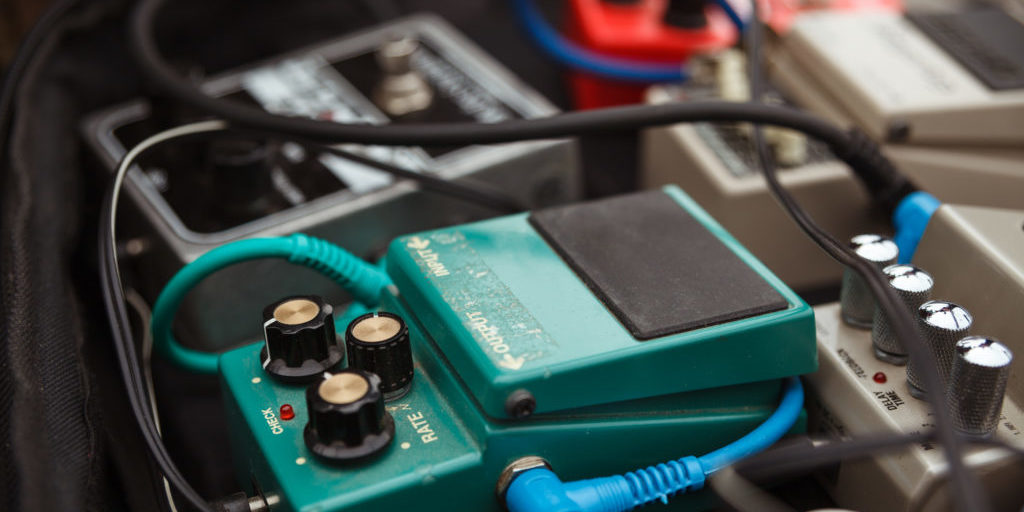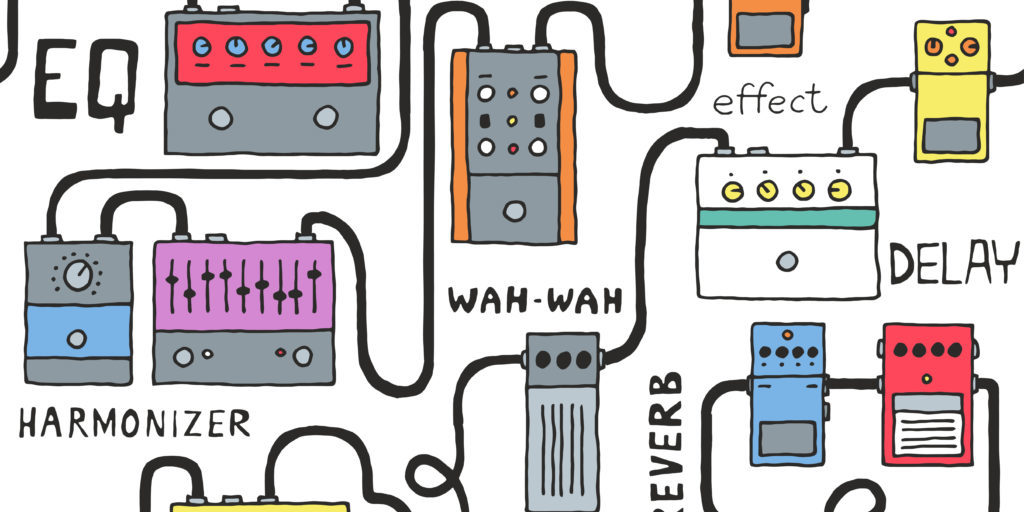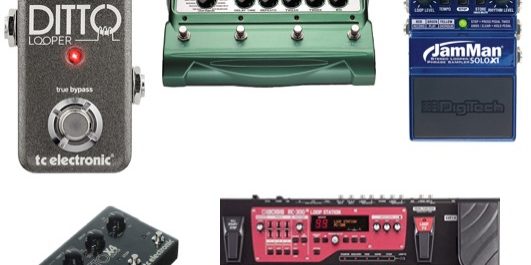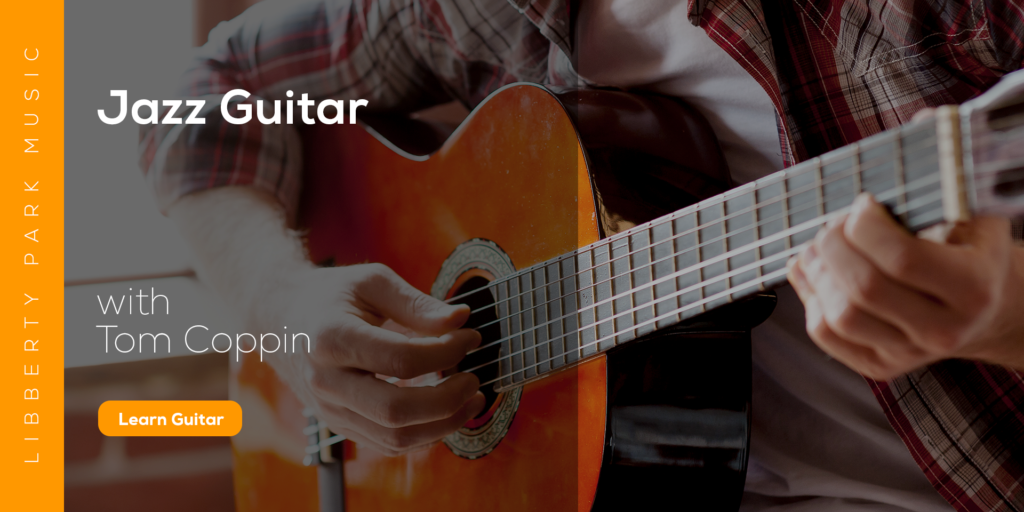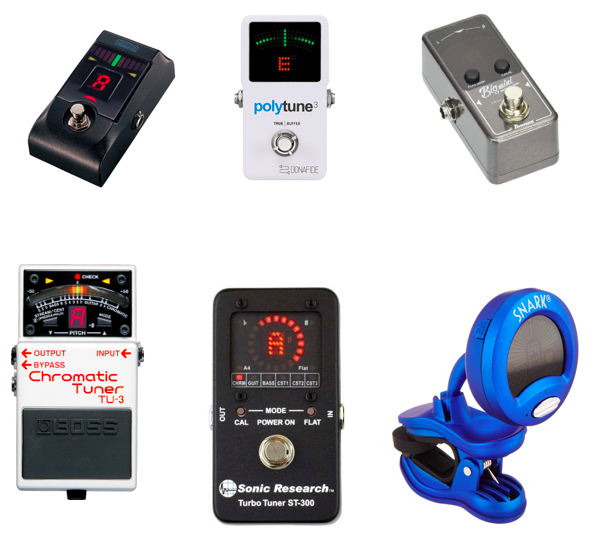
In our series of articles for guitar pedals, we’ve looked at effects like Overdrive, Distortion, Delay, Fuzz, and many other fun effects. However, we’ve neglected to look at possibly the most important pedal on a guitarist’s pedal board--a tuner. Everything about your tone including your effects, amp, and pickups, will be negatively affected by an out-of-tune guitar. Someone with an awesome dirty tone (like Larry Carlton) will still sound bad regardless of playing skills if their strings are out of tune. So really, a great tone begins with having a guitar that is in tune.
Guitar tuners usually come in three forms -- as a guitar pedal, clip on tuner, or smartphone app. Since this article series focuses on guitar pedals, we’ll begin this list with guitar pedal tuners, then we’ll have a few honorable mentions of clip-on tuners and smartphone app tuners.
Before we get into our list of popular tuner pedals, let’s first discuss the differences between a tuner pedal, clip-on tuner, and smartphone app tuner.
A tuner pedal comes in the form of a guitar pedal, and it works by plugging your electric guitar into the pedal with an instrument cable. The pedal then identifies the electrical signal coming in through the instrument cable as a pitch, and displays that pitch on the display of the pedal. This method of tuning is usually the most reliable as there aren’t any external factors that may impact your tuning, unlike a smartphone app tuner.
Smartphone app tuners work by using the microphone on your phone to identify the pitch of the note being played. While this can be very convenient to have, there is one caveat -- your surroundings can’t be too noisy as that can affect the pitch being picked up by the microphone. If you’re playing on stage with a band, smartphone app tuners will be out of the question as the presence of other instruments playing different pitches will confuse the app.
Clip-on tuners are kind of like the in-between of a pedal and an app. Clip-on tuners are usually clipped onto the headstock of your guitar, and it tells pitch by capturing the vibrations of the entire instrument when a note is played. This means that clip-on tuners can work in relatively louder environments, but if the environment is too loud (to the point where the external noise causes your instrument to vibrate), then your clip-on tuner will not work as effectively too.
Now that we have an understanding on the different types of tuners, let’s check out some of the most popular tuner pedals.
1. Korg Pitchblack
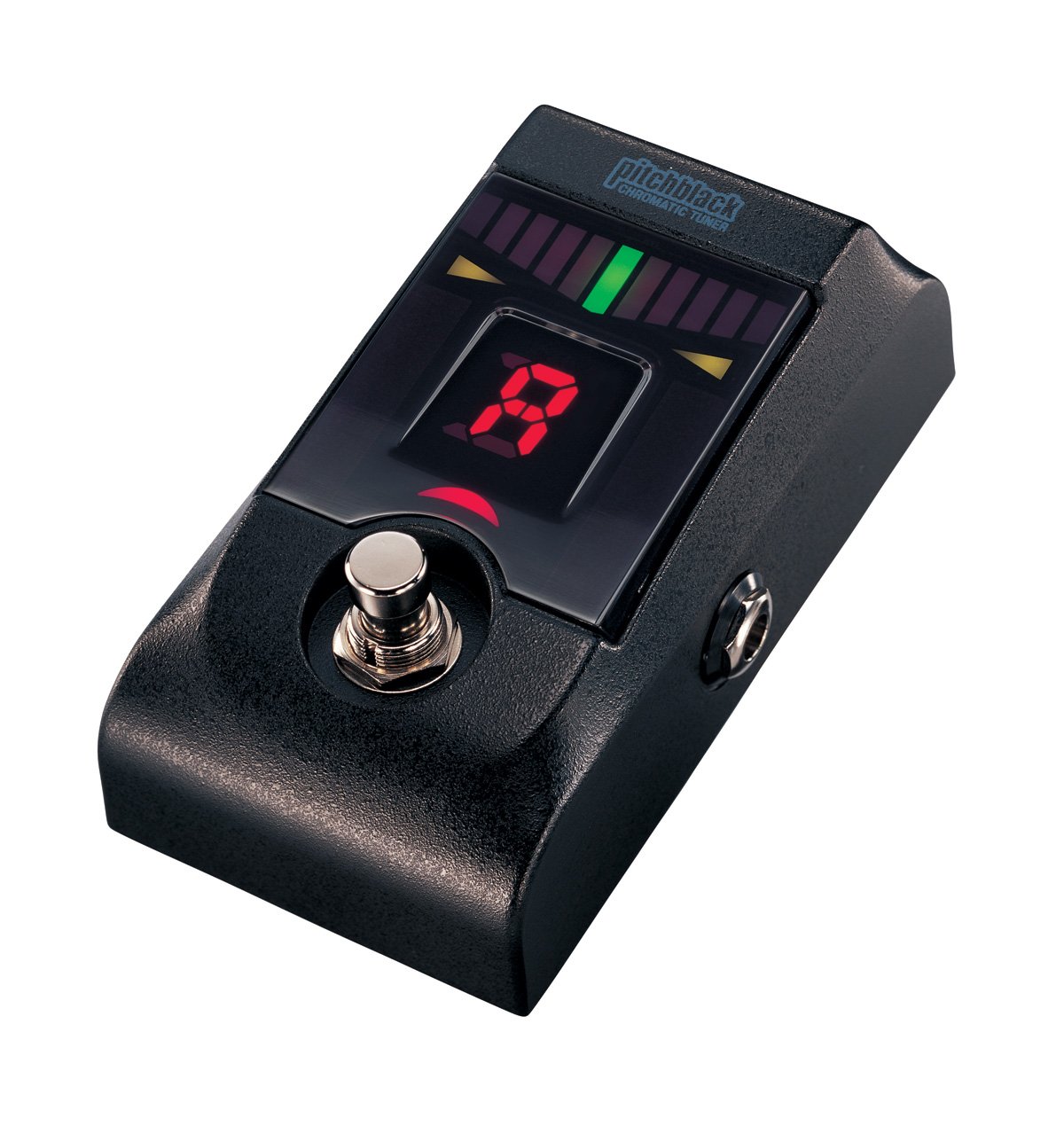
Brand New: $79.99
Used: $30 - $40
The Korg Pitchblack tuner has been around for ages, and it’s easily one of the most popular tuner pedals currently in production. A lot of its popularity can be attributed to its incredibly sturdy construction and low price. The entire pedal is made of aluminum except for the plastic door that covers the battery housing. There is a lone footswitch on the face of the pedal that turns the tuner on and off. When the tuner is activated, the signal running out of the tuner is turned off, meaning your audience won’t hear you awkwardly tuning your guitar during those musical breaks in a song.
One of my favorite things about this pedal is the big and beautiful display that is bright and colorful. Regardless of your lighting conditions, this is one display that you will have no problem reading. The pedal offers you four display modes: Full Strobe, Half Strobe, Meter, and Mirror. Switching between the different display modes doesn’t affect the tuning accuracy, it just switches between different ways of displaying your tuning. Which display mode you choose is down to your preference, but I usually leave it on the default setting and forget about it. There is also a Calibration button at the back of the device that will allow you to adjust your calibration (pitch of A4 note) between 436 Hz to 445 Hz. If you’re not sure what that is for, just leave it on the default 440 Hz.
In terms of accuracy, the Korg Pitchblack is accurate to +/-1 cent which is accurate enough for performance purposes. Additionally, the Pitchblack allows you to daisy chain power cables via the 9V output plug at the back of the pedal. This means that you can use the Pitchblack to supply power to your other pedals on your pedalboard, however, the power consumption of the connected pedals should not exceed 200mA. The Pitchblack itself can be powered with a 9V power supply or battery. The pedal also features true bypass.
Using this pedal is really easy, as all you have to do is turn it on and tune. The pitch being detected also tends to be very steady, unlike some of the lower quality tuners out there that tend to jump around between different pitches, as if the pedal is unsure as to what exact pitch is being played. This may not sound like a big deal, but once you spend enough time tuning your guitar on stage (where seconds matter), you will realize how important a steady tuner is.
While the Pitchblack may not have some of the fancier features like polyphonic tuning and drop tuning, its simplicity and rugged design makes it a really popular choice amongst the pros. Artists that use this pedal include Gary Clark Jr, Steve Vai, and Paul Gilbert.
Buy here
2. TC Electronic Polytune 3
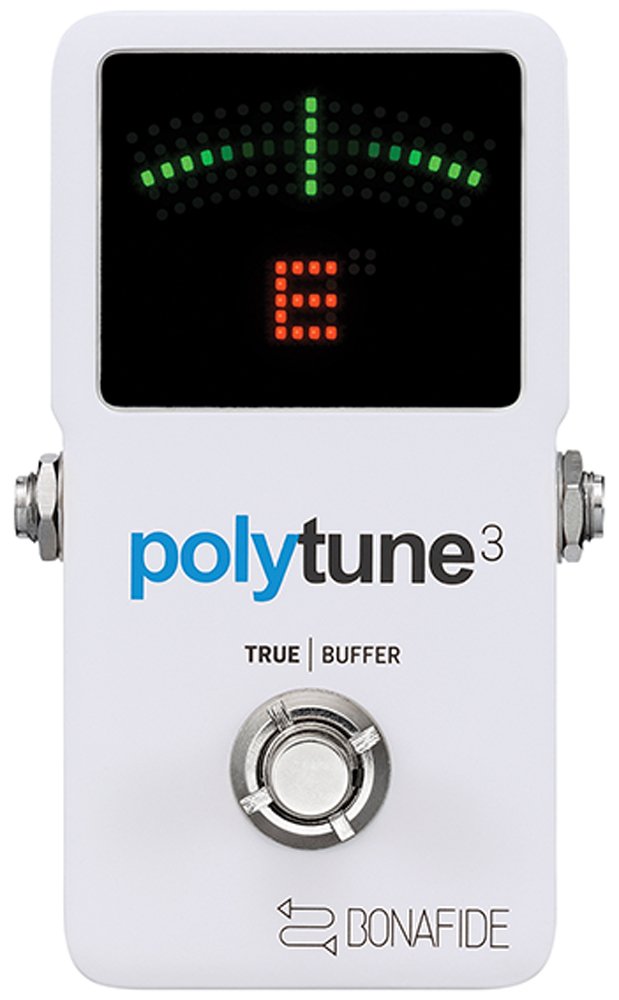
Brand New: $99.99
Used: $45 - $65
The first version of the Polytune surprised many guitarists upon its release as it was the first tuner from a big name manufacturer that offered polyphonic tuning. Before, tuners were monophonic, meaning that the tuner can only read the pitch of one note being played a time. A polyphonic tuner on the other hand will allow you to strum all the strings on your guitar, and the tuner will be able to display the tuning of all six strings. This is very useful when you’re looking to quickly tune up as you can essentially tune all six strings at once.
The construction of the Polytune 3 is sturdy and durable, which is what we’ve come to expect from TC Electronic. And just like other TC Electronic pedals, the footswitch on the Polytune 3 is a soft-click footswitch. Some people prefer this while others prefer a footswitch with a hard-click. Personally, it doesn’t matter to me, but TC Electronic has had issues in the past where their soft-click footswitches would fail after a few years. However, this issue has since been rectified.
The display on this unit can get really bright, which is a huge plus for those outdoor gigs where you have to play under the hot afternoon sun. There is also a sensor in the pedal that detects the lighting condition of your environment, so it adjusts the brightness of the display accordingly.
On the back of the pedal you will see a 9V input and output, and two buttons labeled Tuning and Display. Like the Pitchblack, the Polytune allows you to use your Polytune to power other pedals using a daisy chain method. While the Pitchblack only supports up to 200mA, the Polytune can support up to 2000mA. The tuning switch will allow you to cycle through different tuning modes including standard mode, capo mode, and drop tuning. This means that the Polytune can be configured to help you tune to different tunings besides standard tuning. The display switch allows you to switch between different tuning displays that include guitar needle, guitar strobe, bass needle, and bass strobe. The “needle” modes are the standard modes that can tune accurately up to half a cent and the strobe modes are extremely accurate tuners that tune accurately up to +/-0.02 cent. Using this pedal is quick and easy, and like the Pitchblack, it doesn’t jump around between different pitches thanks to its “tuning magnet” feature.
Some people have expressed concerns that the polyphonic tuning function on the Polytune feels more like a gimmick rather than an actual feature as it can be rather inaccurate at times, but in my experience, it works well enough and can be really useful when you’re in a rush to tune up (for example, during a short musical break in a song).
The Polytune 3 offers true bypass, but it also has a switchable buffered bypass mode that can be useful if you have long cable runs. Having long cables can cause your tone to lose its high end sparkle and some of its dynamics, but a buffer can be placed in the signal chain to maintain the integrity of your signal. This pedal can also be powered using a 9V battery or power supply.
The Polytune series also includes “mini” sized versions of the pedal, but due to the size limitations, some of the features will be missing in the smaller versions of the pedal.
Buy here
3. Ibanez BigMini Tuner
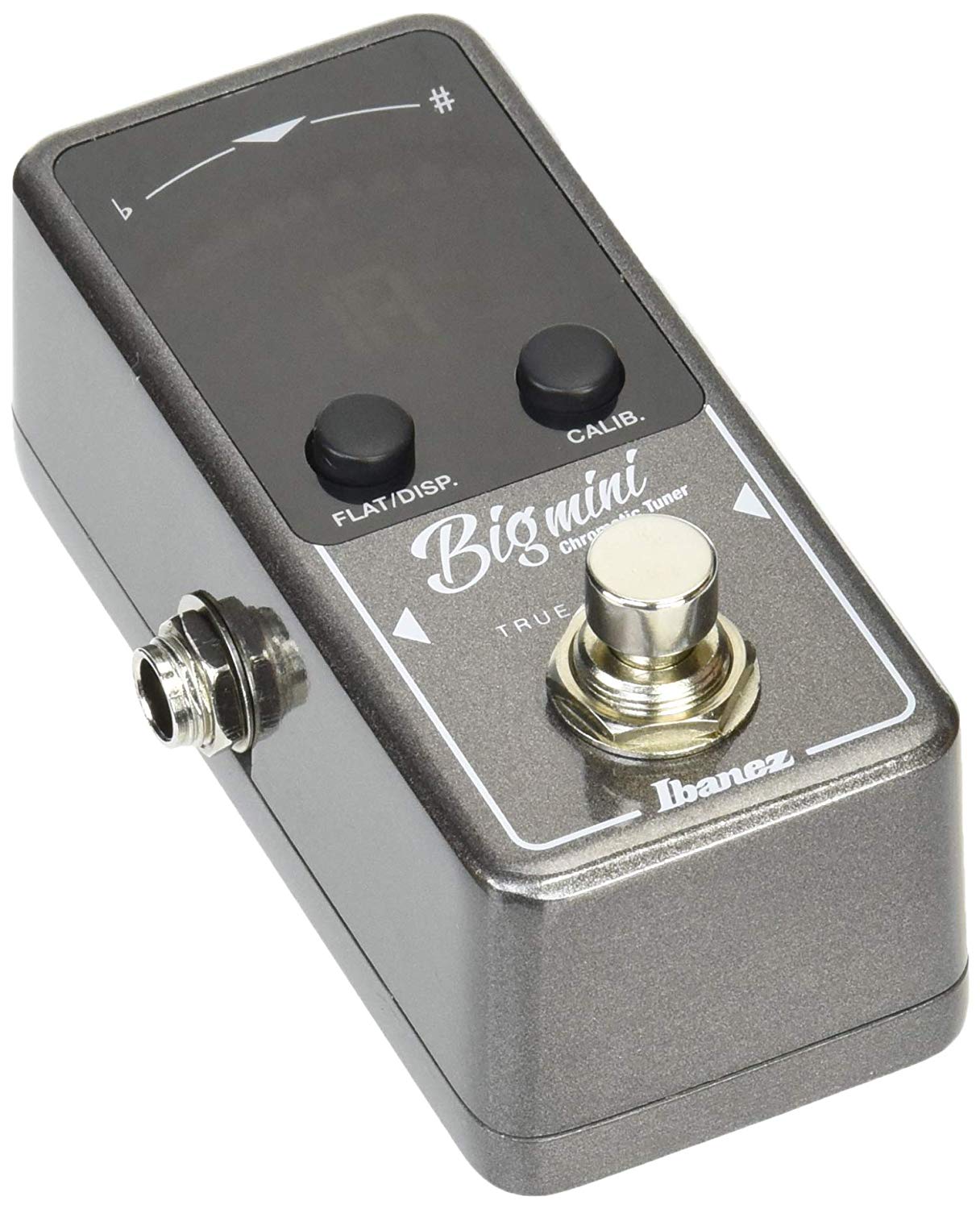
Brand New: $49.99
Used: $25 - $40
While the previously mentioned Polytune mini tuner pedals can be great thanks to their small size and polyphonic tuning function, they do come at a pretty hefty price for a tuner pedal. If you’re looking for a simple tuner pedal that is small in size and won’t break the bank, the Ibanez BigMini Tuner might be something you’ll want to check out. Ibanez is another company that has been building pedals for a long time (they’re the makers of the legendary TS-808 Overdrives), and like the other pedals on this list, it’s really well-built and will be able to withstand a beating.
Similar to the other pedals on this list, the BigMini Tuner has a single footswtich to activate and deactivate the tuner. While the display on the pedal isn’t the greatest, it is bright enough for all sorts of environments that you may find playing yourself in. The face of the pedal also has a display and calibration button for switching between “needle” and “strobe” modes, and for calibrating A4 between 435 to 445 Hz.
The BigMini is accurate up to +/- 1 cent, and it also features true bypass. Unlike the previous two pedals, due to size constraints, the BigMini cannot be powered by a 9V battery. You will have to use to your own 9V power supply as there isn’t one supplied in the box.
Buy here
Learn with LPM
If you are looking to feel comfortable with playing basic major and minor chords, power chords, and apply different strumming techniques to your practices with Ze, check out his course called Rhythm Guitar
4. Boss TU-3
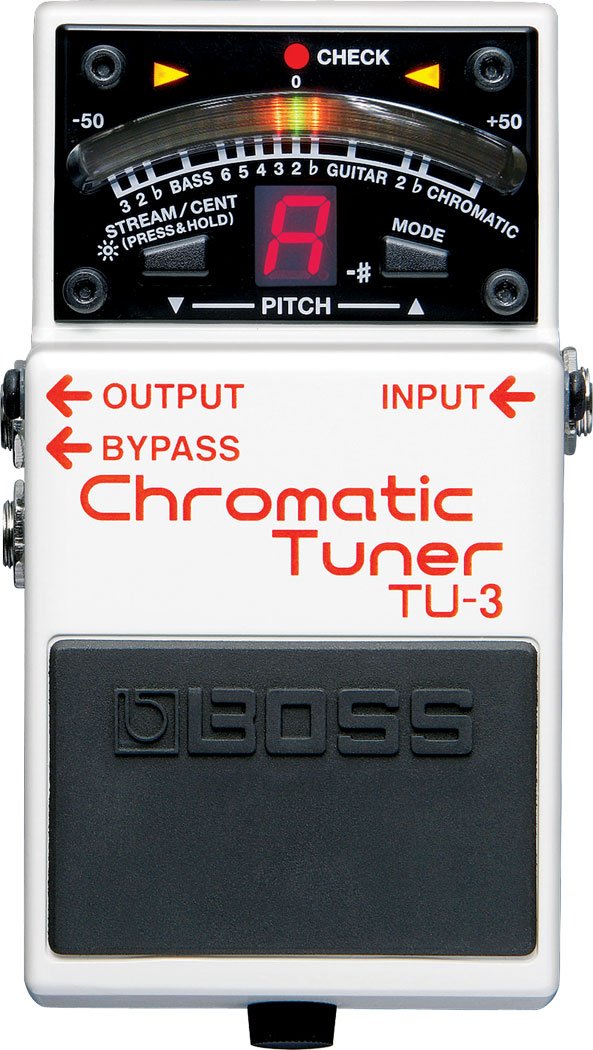
Brand New: $98.89
Used: $55 - $70
Possibly the most popular tuner pedal amongst touring musicians is the Boss TU-3. The TU-3’s predecessor, the TU-2, went down as the top selling tuner pedal of all time, and the TU-3 is more or less the same thing with more features.
One of the main reasons why the TU-3 is such a popular pedal is because of Boss’s reputation for building really tough and reliable pedals. I mentioned that the previous pedals were all really well-built and durable, but Boss pedals take it to another level. Boss’s all-metal enclosures for their pedals ensure that they will last for decades, and there are still Boss pedals from the 70’s being sold on the second-hand market.
The form factor of the pedal comes in the classic Boss case with the footswitch being a rubberized pad instead of a metal footswitch. One thing you’ll notice that’s different about the TU-3 is while the previous pedals only have inputs and output jacks for your instrument cable, the TU-3 has an additional output jack labeled “Bypass.” When the pedal is activated, the output signal will be muted so your audience won’t be able to hear you tuning your pedal, which is similar to the other pedals on this list, but with the TU-3, the Bypass output won’t get muted when the pedal is activated. This can be useful if you’d like to feed the “bypass” signal into a separate speaker to fine tune your guitar with your ears too. You can also use the bypass output as if its a signal splitter and have the separate output go into another amp. Using two amps to set your tone can actually be really fun.
There are two small buttons below the display labeled “STREAM/CENT” and “MODE.” STREAM/CENT allows you to switch between two different ways the pedal displays pitch. It’s a little hard to describe with words what they look like, but the CENT mode is the standard display mode used by most tuners. The MODE button allows you to switch between the different tuning modes. The TU-3 also has modes that allow you to tune to drop tunings. The TU-3 has a tuning accuracy up to +/- one cent, which isn’t as accurate as the Polytune (which is accurate up to half a cent in standard mode, and 0.02 cents in strobe).
The back of the pedal has a 9V input and output, and just like the Korg Pitchblack and TC Electronic Polytune 3, you can daisy-chain the TU-3 to other pedals and use the TU-3 to power them. The TU-3 supports up to 500mA draw from the connected pedals. Besides being powered by a power supply, the TU-3 can also be powered using a 9V battery.
The Boss TU-3 does not come with true bypass which is something I’ve written about several times in previous articles. I’ve personally had issues with Boss pedals that changed my tone enough for me to get rid of them. However, the buffered bypass in Boss pedals can also be really useful if you have a long cable run as it will keep your signal up. Whether you will appreciate the buffered bypass within the TU-3 really comes down to your current set up and base tone. I just wish Boss would release pedals with the option of either true bypass or buffered bypass like the TC Electronic Polytune 3.
Buy here
5. Sonic Research Turbo Tuner ST-300
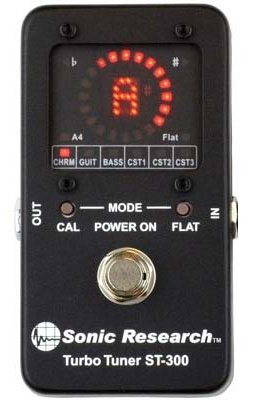
Brand New: $205.20
This last pedal tuner is an odd one out compared to the previous tuners. The first thing that stands out should be the price of the device itself. While it isn’t a very expensive guitar pedal, it is a very expensive tuner. Paying $100 for a tuner is already stretching it, so for a company to charge more than a hundred bucks for a tuner, they’d better have some cool features up their sleeves. Another thing about the Turbo Tuner is that it is pretty difficult to find on the second hand market, and it can only be purchased directly from the manufacturer’s website. So what exactly is it about the Turbo Tuner that justifies its price tag? Well, besides being made in the USA, it’s the only true strobe tuner currently in the market which makes it the most accurate tuner you can currently buy.
A true strobe tuner, or “stroboscope” tuner, works by having the guitar signal drive a strobe light within the pedal. The strobe light will illuminate a disk that rotates at a corresponding frequency, and when the pitch of the guitar signal matches the speed of the rotating disk, the disk will appear to be at a stand still. This method of tuning instruments is currently the most accurate way to do it, which of course begs the question, why do we need our instruments to be so accurately in tune?
Realistically speaking, it’s unlikely that you’ll ever need such an accurate tuner for practice sessions and gigs. However, a highly accurate tuner is a necessity for guitar setups. If you’re the kind of guitarist that sets up your own guitar, you will need a tuner like that to set the intonation of each string as any slight variation in pitch can be amplified as you play different frets along the neck. In short, most people will not find such a tuner to be useful to them, but for those of you who perform your own set-ups (which you really should), a tuner like that may be worth checking out.
The case of the pedal is made of die-cast aluminum, which means that it will last you a really long time. Besides the main footswitch on the face of the pedal, there are also two buttons labeled CAL and FLAT, and they are used to calibrate A4 to different frequencies and setting up custom tunings. There is also a USB connection that will allow you to connect the pedal to a computer to customize tunings through software. The back of the pedal has 9V input and outputs, which gives you the ability to daisy chain other effects pedals to the Turbo Tuner’s power supply, and this pedal also features true bypass.
Using this pedal is quick and easy as the pedal responds very quickly to different notes being played. You can actually play a phrase on your guitar and watch the tuner display the different notes being played. This is a pretty impressive feat considering the other tuners on this list take a bit of time to capture the pitch of the note being played.
Buy here
Honorable Mentions
Tuner pedals are great, and they’re the most reliable and accurate form of tuners out there, but there will be instances where you won’t be able to use a pedal and have to rely on either a clip-on tuner or smartphone app. In those cases, check out the honorable mentions below!
1. Snark Clip-On Tuner
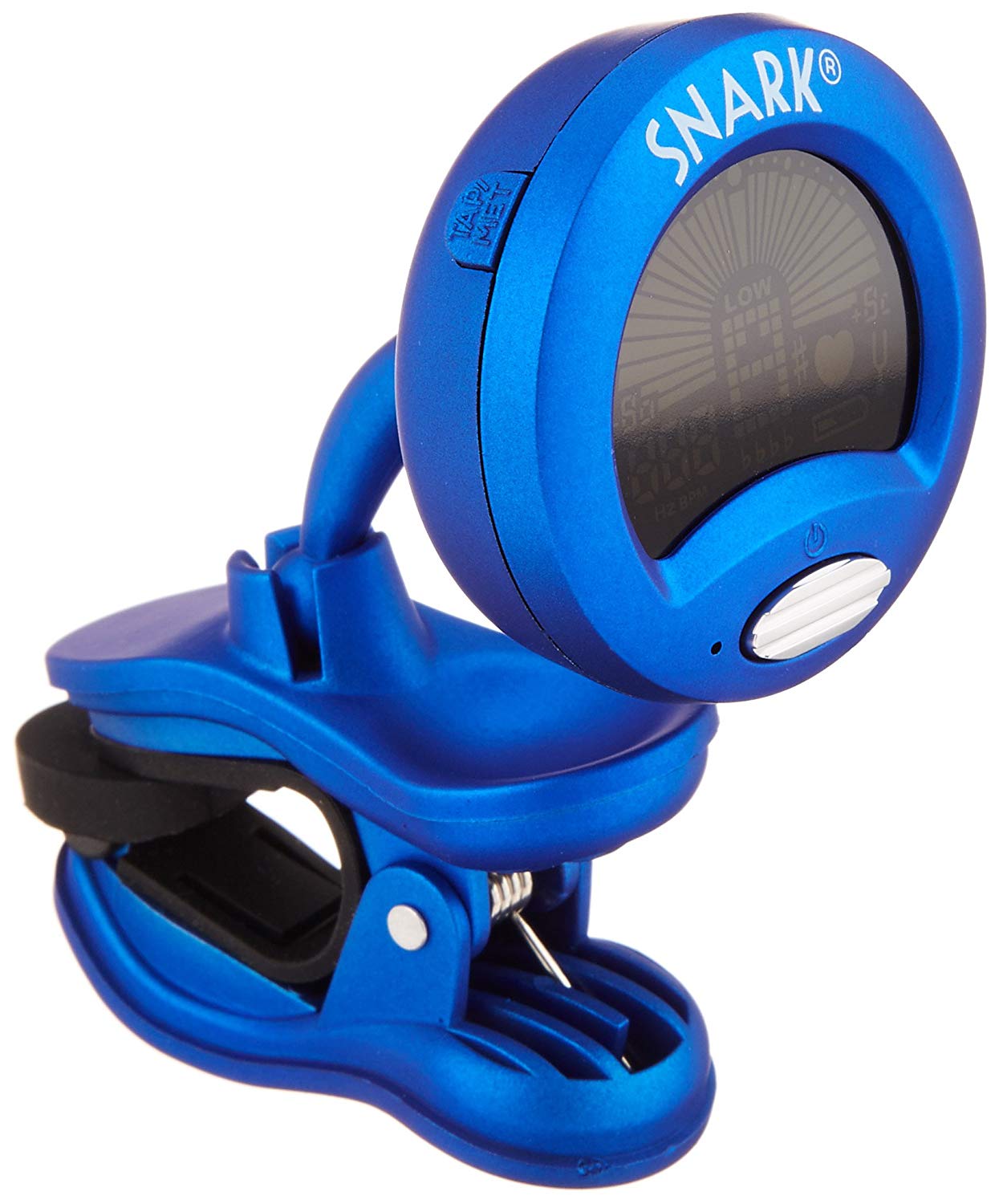
Brand New: $15-30
By far the most popular clip-on tuners currently in the market are produced by Snark. They are small, reliable, and dirt cheap. There are a couple of different models out there with a varying degree of features, but personally, I stick with the standard ST-8. Using this tuner is really simple as all you have to do is clip it to your guitar’s headstock and turn it on to begin tuning. Some models of the Snark will also allow you calibrate A4 to different frequencies, and some even have a metronome function built into them.
The display of the Snark works well enough for a really cheap device, but the tuning accuracy suffers a little bit. It is reported that it is accurate up to +/- 5 cents. While this may be unappealing to some of you, it’s really not too bad. I personally use it on a weekly basis for gigs, and if any string sounds a little off even when the tuner says it’s on pitch, I just use my ears to do tiny adjustments to make it perfect. It also saves you space on your pedalboard, so you can slap on another overdrive pedal to a signal chain that already contains one too many overdrives. If you’re concerned about using this for gigs, trust me, it works well enough (unless you’re playing in a full band setting and have a really loud stage).
The only problem I’ve faced is that they aren’t as durable as pedals, but since they’re so cheap, it doesn’t really matter. The tuner is powered using a tiny CR2032 battery that will last a long, long time.
Buy here
2. GuitarTuna
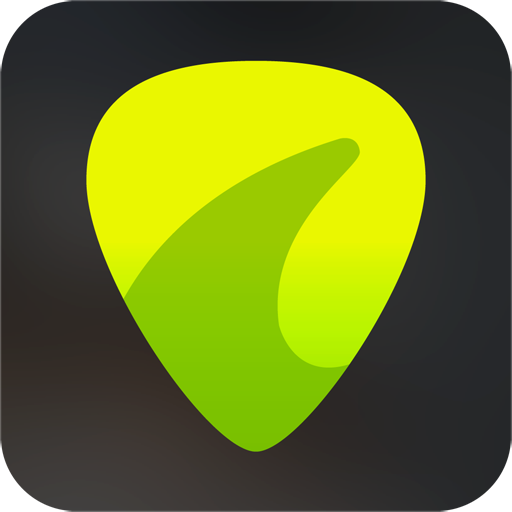
FREE on iOS and Android
Before I begin, I feel like I should mention that I have no affiliation with the app makers of GuitarTuna; I just really like the app. GuitarTuna was made by the same company that runs Yousician, an app-based learning tool for instruments.
The main page of the app is where the tuner lies, and the image they use for the tuner is fantastic. It even shows you which tuning peg to turn for each string! You can also set the tuner to different tunings like drop tunings, open tunings, or really whatever tuning your heart desires. The fact that it works within a smartphone makes it feel really easy to use as most good apps use intuitive interfaces. In the settings page, you can configure the calibration of A4, and you can also turn on the “pro accuracy” mode that makes the tuner a lot more sensitive to different pitches.
Besides being a tuner app, the app also provides a section for guitar-based games. The games include things like a chord identifier and an ear trainer. The chord identifier game will test your chord knowledge by having you identify chord diagrams displayed on the screen, and the ear trainer tests your aural memory with audio clips of chords. Of course, like all modern apps, you can pay a small price to unlock other features and games within the app.
Additionally, there is a built-in metronome in the app that works as you’d expect, as well as a chord library that will allow you to look up any kind of chord you can imagine.
The only complaint I have against this app is the same complaint I have against all tuners that use a microphone to tune -- they can’t be used in loud environments and its accuracy is easily affected by external noise. However, let’s point out the obvious. For the super low price of “free,” there’s really nothing to be complaining about in the first place.
Is there a pedal, clip-on tuner, or app that you feel should be mentioned in this article? Feel free to let us know what they are in the comments below!
Buy here
About the Author: Ze
Ze first began his journey playing original music and top 40s pop tunes around the country's popular venues. Eventually, through the music of John Mayer, he found a strong attraction to blues music. Ze has years of experience teaching beginners and intermediate guitarists. Currently with Liberty Park Music he is teaching Introduction to Guitar Playing for Complete Beginners, Rhythm Guitar to learn about strumming, chords and more, Guitar Essentials as a fast-track review course, and lots of Song Lessons on pop and rock hits.


